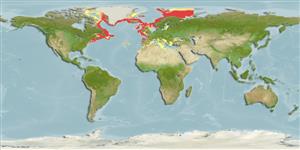Malacostraca |
Euphausiacea |
Euphausiidae
Environment: milieu / climate zone / djupintervall / distribution range
Ekologi
Pelagiska; djupintervall 100 - 600 m (Ref. 96715), usually ? - 500 m (Ref. 118505). Boreal; 2°C - 15°C (Ref. 118496), preferred 4°C (Ref. 107945); 80°N - 27°N, 78°W - 52°E (Ref. 118505)
Arctic, Atlantic and the Mediterranean: from North Carolina, USA and Canada (Hudson Strait) to 52°E in Novaya Zemlya, Russia, north to Fram Strait and south to Cape Juby, Morocco.
Length at first maturity / Size / Weight / Age
Könsmognad: Lm ?, range 3 - 3.5 cm Max length : 4.0 cm TL hane/ej könsbestämd; (Ref. 2864); rapporterad maxålder: 2.00 år (Ref. 130001)
Minimum depth range from Ref. 118505. This is an omnivorous species (Refs. 96715, 118584) (Ref. 356).
Life cycle and mating behavior
Könsmognad | Reproduktion | Lek | Eggs | Fecundity | Larvae
Brinton, E. 1962 The distribution of Pacific euphausiids. 8(2), 51-270. In Fox, D.L., Arrhenius, G.O.S., Phleger, F.B. (eds.), Contribution from the Scripps Institution of Oceanography. Bulletin of the Scripps Institution of Oceanography of the Univeristy of California. University of California Press. California. (Ref. 2864)
IUCN Red List Status
(Ref. 130435: Version 2025-1)
CITES status (Ref. 108899)
Not Evaluated
Not Evaluated
Threat to humans
Human uses
Fiskeri: kommersiell
FAO - fiskeri: landings | FishSource | Sea Around Us
Verktyg
Ytterligare information
Life cycleReproduktionKönsmognadFecundityLekEggsEgg developmentLarvae PhysiologySyreförbrukning
Human RelatedStamps, coins, misc.
Internet-källor
Estimates based on models
Preferred temperature
(Ref.
115969): 1.6 - 11.1, mean 3.6 (based on 68 cells).
Resiliens
Hög, lägsta populationsfördubblingstid mindre än 15 månader (tm=1; tmax=2).
Fishing Vulnerability
Low vulnerability (10 of 100).
Climate Vulnerability
Low to moderate vulnerability (28 of 100).
Price category
Unknown.
Nutrients : Calcium = 109 [35, 184] mg/100g; Iron = 1.59 [1.21, 1.97] mg/100g; Protein = 20.2 [19.2, 21.3] %; Omega3 = 0.285 [0.185, 0.386] g/100g; Selenium = 48.3 [-31.7, 128.3] μg/100g; VitaminA = 0 μg/100g; Zinc = 1.79 [1.17, 2.40] mg/100g (wet weight); based on
nutrient studies.
